2009 Hyundai Accent fuel
[x] Cancel search: fuelPage 63 of 232
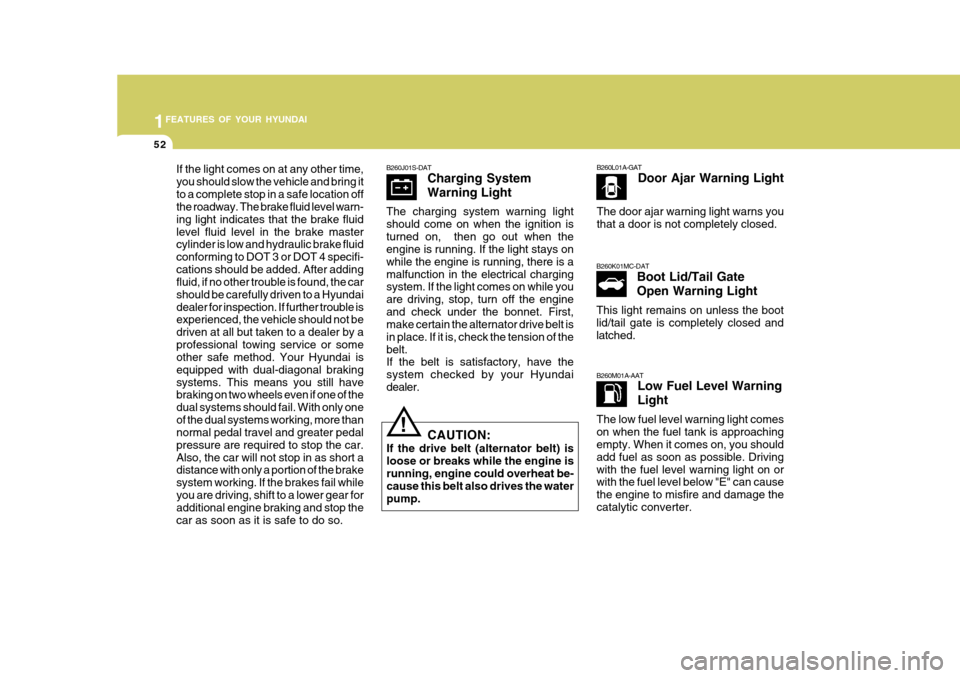
1FEATURES OF YOUR HYUNDAI
52
B260J01S-DATCharging System Warning Light
The charging system warning light should come on when the ignition isturned on, then go out when the engine is running. If the light stays on while the engine is running, there is amalfunction in the electrical charging system. If the light comes on while you are driving, stop, turn off the engineand check under the bonnet. First, make certain the alternator drive belt is in place. If it is, check the tension of thebelt. If the belt is satisfactory, have the system checked by your Hyundaidealer. B260M01A-AAT
Low Fuel Level Warning Light
The low fuel level warning light comes on when the fuel tank is approaching empty. When it comes on, you should add fuel as soon as possible. Drivingwith the fuel level warning light on or with the fuel level below "E" can cause the engine to misfire and damage thecatalytic converter.
! CAUTION:
If the drive belt (alternator belt) is loose or breaks while the engine isrunning, engine could overheat be- cause this belt also drives the water pump. B260L01A-GAT
Door Ajar Warning Light
The door ajar warning light warns youthat a door is not completely closed.
If the light comes on at any other time, you should slow the vehicle and bring itto a complete stop in a safe location off the roadway. The brake fluid level warn- ing light indicates that the brake fluidlevel fluid level in the brake master cylinder is low and hydraulic brake fluid conforming to DOT 3 or DOT 4 specifi-cations should be added. After adding fluid, if no other trouble is found, the car should be carefully driven to a Hyundaidealer for inspection. If further trouble is experienced, the vehicle should not be driven at all but taken to a dealer by aprofessional towing service or some other safe method. Your Hyundai is equipped with dual-diagonal brakingsystems. This means you still have braking on two wheels even if one of the dual systems should fail. With only oneof the dual systems working, more than normal pedal travel and greater pedal pressure are required to stop the car.Also, the car will not stop in as short a distance with only a portion of the brake system working. If the brakes fail whileyou are driving, shift to a lower gear for additional engine braking and stop the car as soon as it is safe to do so. B260K01MC-DAT
Boot Lid/Tail Gate Open Warning Light
This light remains on unless the boot lid/tail gate is completely closed andlatched.
Page 64 of 232

1
FEATURES OF YOUR HYUNDAI
53
If the Emission Control System Mal- function Indicator Light begins toflash ON and OFF, potential catalytic converter damage is possible which could result in loss of engine power.Have the Engine Control System in- spected as soon as possible by an authorised Hyundai dealer.
B260N01MC-DAT Malfunction Indicator Light
This light illuminates when there is a malfunction of an exhaust gas relatedcomponent, and the system is not func- tioning properly so that the exha ust gas
regulation values are not satisfied. This light will also illuminate when the ignition
key is turned to the "ON" position, and then it will go out in a few seconds after
the engine is started. If it illuminates
while driving, or does not illuminate whenthe ignition key is turned to the "ON"position, take your car to your nearest
authorised Hyundai dealer and have the system checked.
CAUTION:
Prolonged driving with the Emis- sion Control System Malfunction Indicator Light illuminated may cause damage to the emission con-trol systems which could effect drivability or fuel economy.!
B290A02MC-DAT Engine Coolant Tempera-
ture Warning Light
warning:
Never remove the radiator cap when the engine is hot. The engine coolant is under pressure and could erupt and cause severe burns. Wait untilthe engine is cool before removing the radiator cap.
!
This warning light shows the tempera- ture of the engine coolant when the ignition switch is ON. The warning light illuminates if the temperature of theengine coolant is above 123±3°C (253.4±5.4°F). If the warning light illuminates, pull overand stop as soon as possible and turn off the engine. Then open the bonnet and check the coolant level (See "If theengine overheats" on the page 3-4.) and the water pump drive belt. If you sus- pect cooling system trouble, have yourcooling system checked by a Hyundai dealer as soon as possible.
Page 66 of 232

1
FEATURES OF YOUR HYUNDAI
55INSTRUMENT CLUSTER
The needle on the gauge indicates the approximate fuel level in the fuel tank. The fuel capacity is given in Section 9. NOTE: The "
" symbol means the fuel
filler lid is placed on the left side of the vehicle.
B280A02TG-AAT FUEL GAUGE
OMC029420
Type AType B
B270A01A-AAT BRAKE PAD WEAR WARNING SOUND The front disc brake pads have wear indicators that should make a high-pitched squealing or scraping noise when new pads are needed. The sound may come and go or be heard all thetime when the vehicle is moving. It may also be heard when the brake pedal is pushed down firmly. Exces-sive rotor damage will result if the worn pads are not replaced. See your Hyundai dealer immediately.
B265C01NF-DAT
Electronic Stability Program Indicator Lights(If Installed)
The electronic stability program indica- tors change operation according to the ignition switch position and whether thesystem is in operation or not. They will illuminate when the ignition key is turned to the "ON" position, but should go outafter three seconds. If the ESP or ESP- OFF indicator stays on, take your car to your authorised Hyundai dealer andhave the system checked. See section 2 for more information about the ESP.
CAUTION:
Avoid driving with a very low fuel level. If you run out of fuel, it could cause the engine to misfire and re-sult in excessive loading of the cata- lytic converter.!
Page 69 of 232
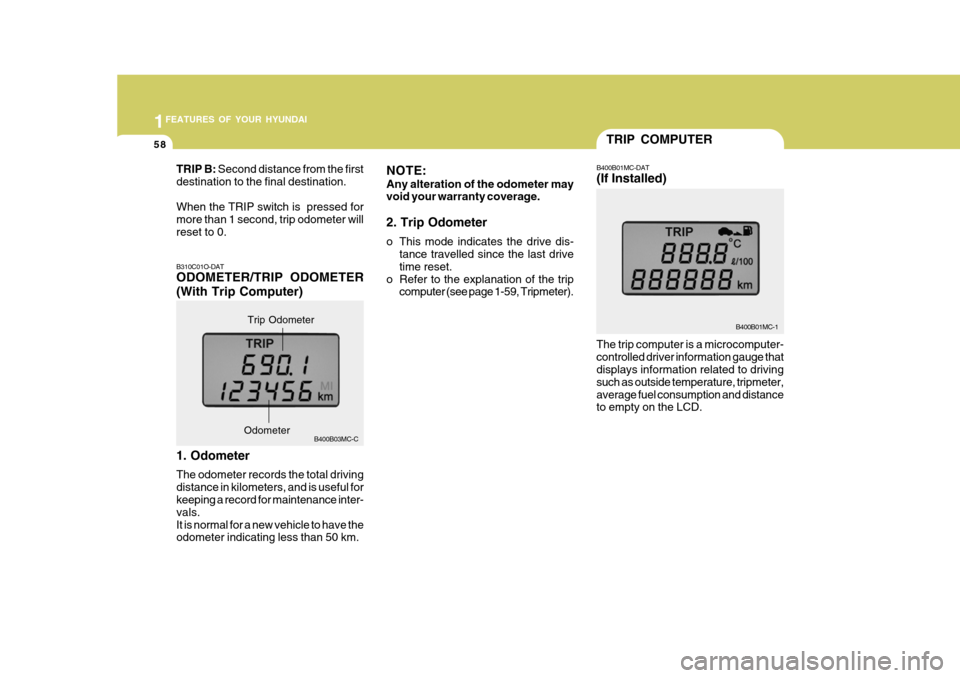
1FEATURES OF YOUR HYUNDAI
58
TRIP B: Second distance from the first
destination to the final destination. When the TRIP switch is pressed for more than 1 second, trip odometer willreset to 0. NOTE: Any alteration of the odometer may void your warranty coverage. 2. Trip Odometer
o This mode indicates the drive dis-
tance travelled since the last drive time reset.
o Refer to the explanation of the trip computer (see page 1-59, Tripmeter).
B310C01O-DAT ODOMETER/TRIP ODOMETER (With Trip Computer) 1. Odometer The odometer records the total driving distance in kilometers, and is useful for keeping a record for maintenance inter- vals.It is normal for a new vehicle to have the odometer indicating less than 50 km. B400B03MC-C
Trip Odometer
Odometer
TRIP COMPUTER
B400B01MC-1
The trip computer is a microcomputer- controlled driver information gauge that displays information related to driving such as outside temperature, tripmeter,average fuel consumption and distance to empty on the LCD. B400B01MC-DAT (If Installed)
Page 70 of 232
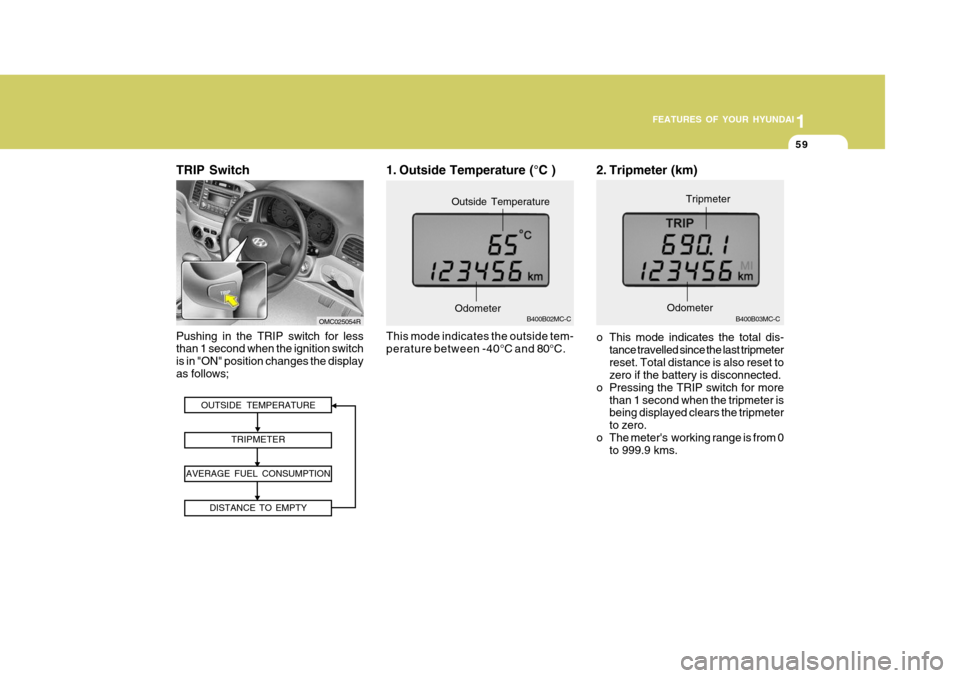
1
FEATURES OF YOUR HYUNDAI
59
OUTSIDE TEMPERATURE
TRIPMETER
AVERAGE FUEL CONSUMPTION DISTANCE TO EMPTY
TRIP Switch Pushing in the TRIP switch for less than 1 second when the ignition switch is in "ON" position changes the displayas follows;1. Outside Temperature (°C ) This mode indicates the outside tem-
perature between -40°C and 80°C. B400B02MC-C
Odometer
Outside Temperature
2. Tripmeter (km)
o This mode indicates the total dis-
tance travelled since the last tripmeter reset. Total distance is also reset to zero if the battery is disconnected.
o Pressing the TRIP switch for more
than 1 second when the tripmeter isbeing displayed clears the tripmeter to zero.
o The meter's working range is from 0 to 999.9 kms. B400B03MC-C
Odometer Tripmeter
OMC025054R
Page 71 of 232
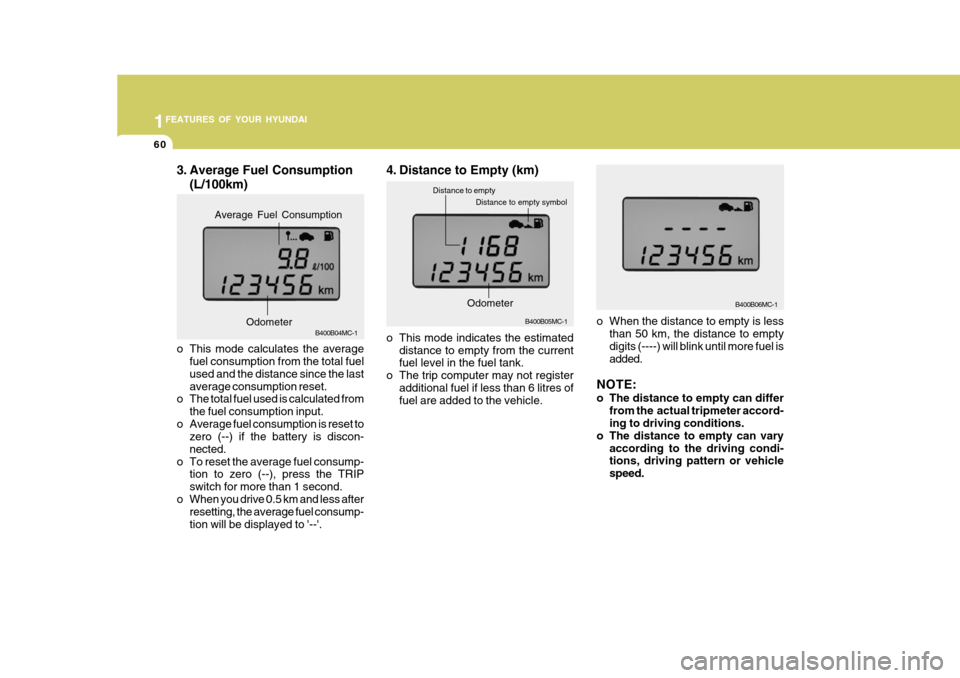
1FEATURES OF YOUR HYUNDAI
60
3. Average Fuel Consumption
(L/100km)
B400B04MC-1
o This mode calculates the average fuel consumption from the total fuel used and the distance since the lastaverage consumption reset.
o The total fuel used is calculated from
the fuel consumption input.
o Average fuel consumption is reset to zero (--) if the battery is discon-nected.
o To reset the average fuel consump- tion to zero (--), press the TRIPswitch for more than 1 second.
o When you drive 0.5 km and less after resetting, the average fuel consump-tion will be displayed to '--'.
Odometer
Average Fuel Consumption
o When the distance to empty is less
than 50 km, the distance to empty digits (----) will blink until more fuel isadded.
NOTE:
o The distance to empty can differ from the actual tripmeter accord- ing to driving conditions.
o The distance to empty can vary according to the driving condi-tions, driving pattern or vehicle speed.
4. Distance to Empty (km)
o This mode indicates the estimated
distance to empty from the current fuel level in the fuel tank.
o The trip computer may not register additional fuel if less than 6 litres offuel are added to the vehicle. B400B05MC-1
Distance to empty symbol
Distance to empty
Odometer
B400B06MC-1
Page 91 of 232
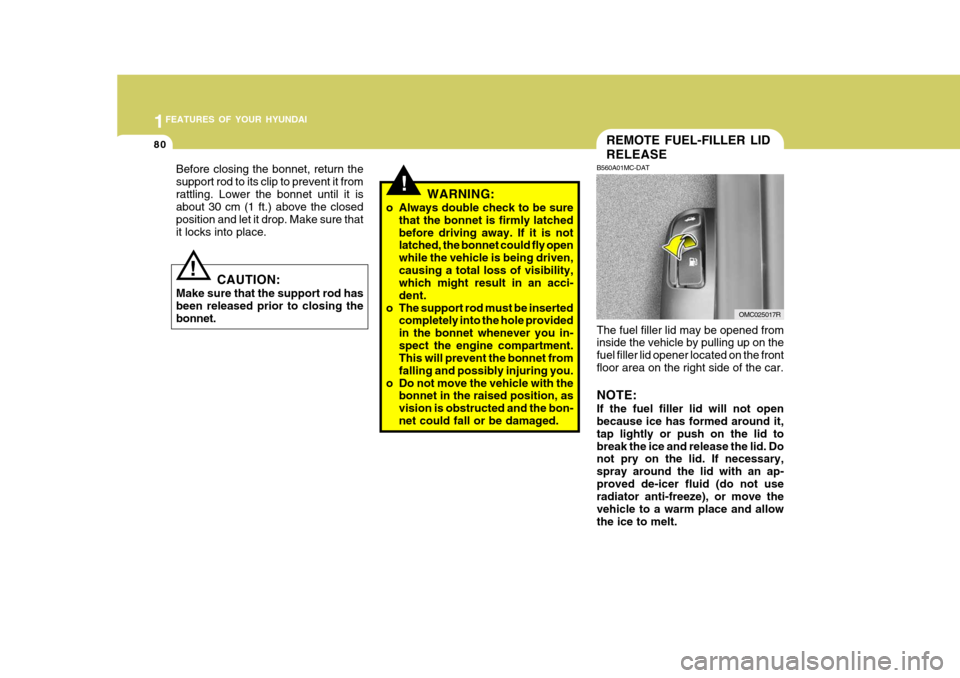
1FEATURES OF YOUR HYUNDAI
80REMOTE FUEL-FILLER LID RELEASE
B560A01MC-DAT The fuel filler lid may be opened from inside the vehicle by pulling up on the fuel filler lid opener located on the frontfloor area on the right side of the car. NOTE: If the fuel filler lid will not open because ice has formed around it, tap lightly or push on the lid tobreak the ice and release the lid. Do not pry on the lid. If necessary, spray around the lid with an ap-proved de-icer fluid (do not use radiator anti-freeze), or move the vehicle to a warm place and allowthe ice to melt.
OMC025017R
Before closing the bonnet, return the support rod to its clip to prevent it fromrattling. Lower the bonnet until it is about 30 cm (1 ft.) above the closed position and let it drop. Make sure thatit locks into place.
!
CAUTION:
Make sure that the support rod has been released prior to closing the bonnet.
!WARNING:
o Always double check to be sure that the bonnet is firmly latched before driving away. If it is not latched, the bonnet could fly open while the vehicle is being driven,causing a total loss of visibility, which might result in an acci- dent.
o The support rod must be inserted completely into the hole providedin the bonnet whenever you in-spect the engine compartment. This will prevent the bonnet from falling and possibly injuring you.
o Do not move the vehicle with the bonnet in the raised position, asvision is obstructed and the bon-net could fall or be damaged.
Page 92 of 232

1
FEATURES OF YOUR HYUNDAI
81
!WARNING:
o Fuel vapours are dangerous. Be- fore refuelling, always stop the engine and never allow sparks oropen flames near the filler area. If you need to replace the filler cap, use a genuine Hyundai replace-ment part. If you open the fuel filler cap dur- ing high ambient temperatures, aslight "pressure sound" may be heard. This is normal and not a cause for concern. Whenever you open the fuel filler cap, turn it slowly.
o Automotive fuels are flammable/ explosive materials. When refuel-ling, please note the followingguidelines carefully. Failure to follow these guidelines may re- sult in severe personal injury, se-vere burns or death by fire or explosion.
- Before refuelling always note the
location of the Emergency Petrol Shut-Off, if available, at the petrol station facility.
B560A02MC
4 Door
B560A02MC-1
3 Door
- Before touching the fuel nozzle
or fuel filler cap, you should eliminate potentially dangerous static electricity discharge by touching another metal part ofthe front of the vehicle, a safe distance away from the fuel filler neck, nozzle, or other flammablesource.
- Do not get back into a vehicle
once you have begun refuelling.Do not touch, rub or slide against any item or fabric (polyester, satin, nylon, etc.) capable of pro-ducing static electricity. Static electricity discharge can ignite fuel vapours resulting in explo-sion. If you must re-enter the vehicle, you should once again elimi-nate potentially dangerous static electricity discharge by touch- ing a metal part of the vehicle,away from the fuel filler neck, nozzle or other petrol source.